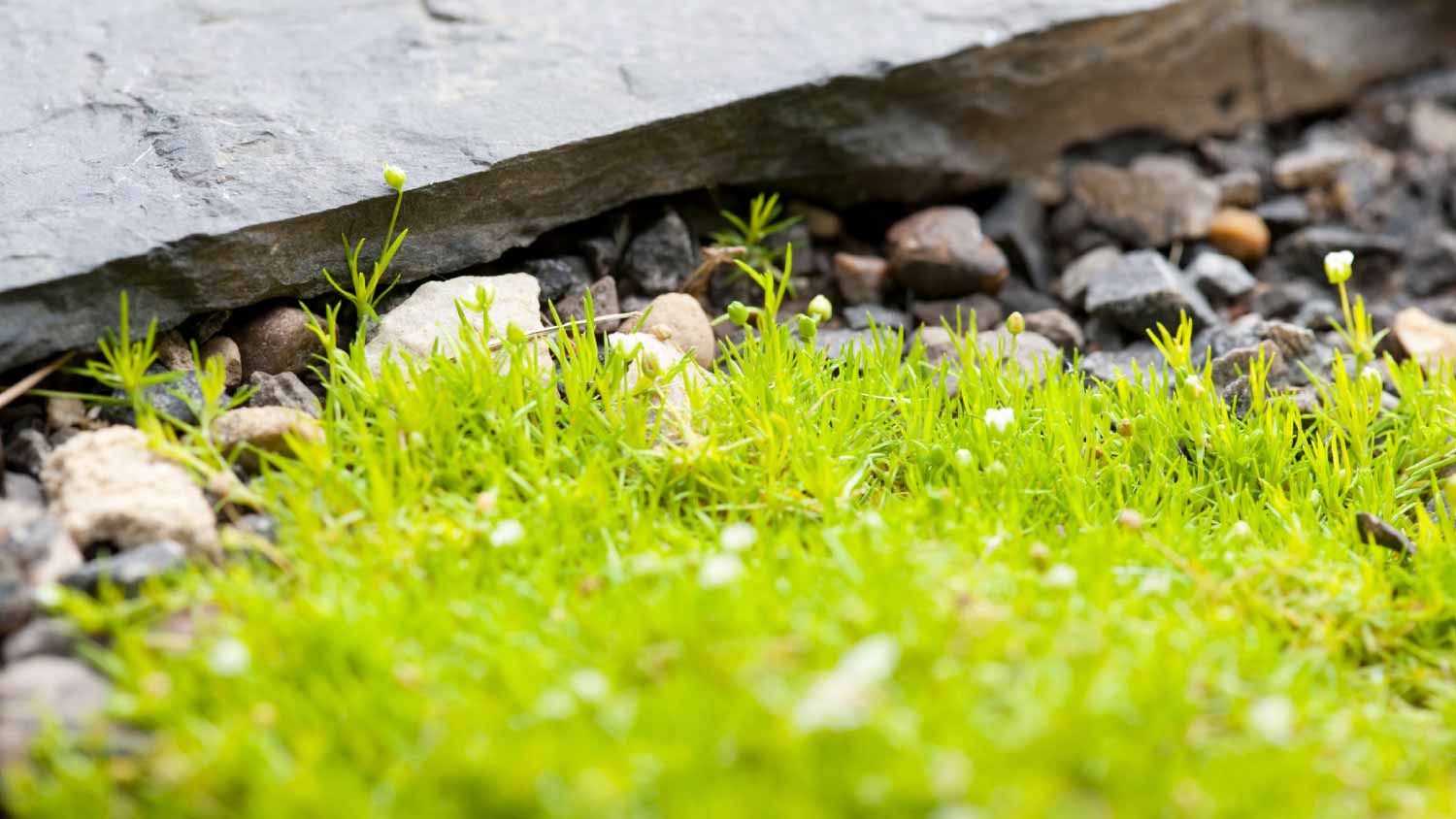How to Edge a Lawn Like a Pro
Make gorgeous lines in your yard by performing this simple lawn edging process


- Protective eyewear
- Boots
- Full-coverage clothing
- Lawn mower
- Lawn string trimmer (optional)
- Stakes
- String
- Grass marking spray (optional)
If you’ve ever admired neat edges of grass surrounding a walkway, driveway, or garden, you have likely seen evidence of expertly done lawn edging. Learning how to edge a lawn can really make your yard pop, and it helps keep turfgrass and weeds from spilling out over plant beds and gardens. If you’re ready to take a whack at edging your lawn, this guide breaks down the lawn edging process so you can confidently start this project.
Prepping to Edge Your Lawn
Gather your gear ahead to avoid hassles and ensure you don’t have to stop halfway through the edging process. Wear comfortable and protective clothing, such as boots, long pants, and protective goggles. Sticks and stones will likely kick up into the air as you edge, so protect as much of your body as possible. You should also set out a lawn mower, string trimmer, and stiff cleaning brush.
Plan Out Your Edging
 Photo: ziggy1 / iStock / Getty Images
Photo: ziggy1 / iStock / Getty ImagesBefore you get started, decide how you want your edging to look. You might want to follow the natural curved lines of your flower bed. Or you might want straight lines throughout your yard. Either way, this step is important, especially if you’re using landscape edging to give your yard stylish yet low-maintenance edges.
Mow the Lawn
 Photo: Westend61 / Getty Images
Photo: Westend61 / Getty ImagesIt’s best to mow the rest of the lawn as you ordinarily would immediately before straightening the edges. This will give you a vital visual cue as to how short you should trim the grass along the edges later. If you do not mow first, you could over-trim the edges and give rise to bare and weed-filled patches.
If you typically hire a pro and pay for professional lawn mowing costs, just begin this process shortly after they have finished.
Choose Your Edging Tools
 Photo: ungvar / Adobe Stock
Photo: ungvar / Adobe StockThere are various edging tools you can use to tackle this project. Here are the most popular options and when it might be best to use them:
String trimmer: Whether gas-powered, electrical, or cordless, string trimmers can be a versatile tool in a homeowner’s arsenal. It’s typically the tool that most homeowners have on hand that cuts through the grass as its trimmer head rotates. They can be used to create straight or curved lines by driveways or flower beds.
Electric edger: These tools are purely dedicated to giving your edges precise, clean lines. And like string trimmers, you can use them for various edging needs.
Half-moon edger: Half-moon edgers are manual tools that give you more control over your edge and edging small lawns.
Hand shear: While you wouldn’t use hand shears for your entire yard, they’re great for touching up edges.
For edging large lawns, use a power tool to get clean, crisp lines. Both string trimmers and dedicated edgers are great for the job, though edgers are a little more effective.
Map Out Your Edging
 Photo: Lux pictura / Adobe Stock
Photo: Lux pictura / Adobe StockNow that you’ve mowed your grass, have a rough idea of how you want your edges to look, and know what tools you will use, you need to map it out. Use string and stakes to help you outline your edge. This will help you label any waterlines, get a more precise edge, and see how it looks—in case you change your mind—before you start edging your lawn.
For new edges, use a half-moon edger to map along the outline you created with your string and stakes, cutting into the dirt as you go. Then, go on the inside of your outline for your second cut. This cut will meet up with your first cut and form a V shape, allowing you to keep your flower beds or tree edges nice and crisp. Use your half-moon edger to loosen and remove dirt, placing it in a wheelbarrow. If you’re using an electric edger, use grass marking spray to help you outline your edges.
Edge Your Lawn With an Electric Edger
 Photo: geargodz / Adobe Stock Images
Photo: geargodz / Adobe Stock ImagesTo use an edger to edge your lawn, first practice edging your lawn on a hidden patch. Once you feel confident in your ability, start at the beginning of your outline. Then, position your edger so the deflector shield faces you. Now, start your edger and cut along your marked path. Near your driveway or sidewalk, walk backward with it to give a second pass if you’re not sure if it went through the dirt.
Flip the Trimmer Around
 Photo: CatLane / iStock / Getty Images Plus / Getty Images
Photo: CatLane / iStock / Getty Images Plus / Getty ImagesWhen learning how to edge your lawn with a standard string trimmer, how you handle it matters. Flip the trimmer around a full 180 degrees so it is vertical. Take great care to ensure the deflector shield is facing your body, as it will catch a fair number of rocks, sticks, and errant pieces of grass.
Control the Trimmer
 Photo: DonNichols / iStock / Getty Images Plus / Getty Images
Photo: DonNichols / iStock / Getty Images Plus / Getty ImagesTo achieve ultra-straight edges like the pros, handle the trimmer correctly. Practice maneuvering the trimmer for a few minutes before you begin. Once you have begun, keep the string trimmer level and in the same position. Keep your arms steady as you walk, and trim left to right. Move slowly and with purpose along your outline as you work around the edges of your lawn.
Most string trimmers spin clockwise, so working left to right will ensure that it ejects trimmings away from walkways and flower beds. This will save you time during cleanup.
Follow the Paths
 Photo: nd700 / Adobe Stock
Photo: nd700 / Adobe StockNow you’re on a roll. Go slowly and follow the outlined paths in your yard. Walk on any hard surface as you edge if you’re edging your driveway or sidewalk. Keep the trim line in that small space between the grass and the hardscape when needed. Patiently cut it back a little bit at a time by working the trimmer’s string against the walkway, driveway, or flower bed.
Clean Up
 Photo: Quintin / Adobe Stock
Photo: Quintin / Adobe StockCleaning up will be a breeze, providing you moved left to right as you edged the lawn. The string trimmer should have ejected trimmings onto the yard itself, so you won’t have to worry about cleaning your walkways or gardens. You should, however, clean your power tool with a stiff brush so it will be ready to go next time.
Maintain Your Edges
 Photo: bbstudio_ada / Adobe Stock
Photo: bbstudio_ada / Adobe StockKnowing how to edge a lawn is only half the battle. The real work is keeping it that way. Here are a few ways to keep those edges nice and tidy:
Edge your lawn at least once a year.
Follow the edge’s path when mowing.
Blow or rake cut grass to minimize weed growth.
DIY vs. Hiring a Pro to Edge Your Lawn
Edging can be a relatively inexpensive DIY project that won’t take up too much of your time. If you already have a string trimmer and a lawn mower, your out-of-pocket costs should be zero.
A decent string trimmer will cost $150 to $250, and lawn mowers will cost as little as $100 for reel mowers all the way up to $2,400 for robot lawnmowers. If you have a large lawn you want to edge but don’t want to create those edges yourself or shell out a few hundred dollars for a dedicated edge trimmer, your local landscaper can handle this for you.
Hiring a professional landscaper will cost you about $100 to $200 per month, and services will include lawn edging, lawn mowing, hedging, and general upkeep.
Lawrence Bonk contributed to this piece.
Frequently Asked Questions
A dry lawn is easier to edge than a wet one. When your ground is wet, your blades will likely clump together, making a seemingly even cut while wet, but an uneven disaster when dried. Also, a wet lawn can impact your blade's performance and cause mud to kick up, resulting in a messy finish.
When you’re ready to edge your lawn, mowing your grass first is better. By mowing it, you’ll know whether you’ll need to trim it more along the edges later. If you edge your lawn first, it can result in bare patches, giving it an inconsistent finish. Plus, mowing first really diminishes the look of a freshly edged lawn.
No, you don’t need to edge your lawn every time you mow it, but you can if that’s your preference. Some homeowners edge their lawns weekly, every other week, monthly, or at the start of a new season (more likely for those with landscaping material like brick, plastic, or metal edging). It’s up to you how often you edge, and it depends on how quickly your grass grows and how crisp you want your edge lines to be.





















